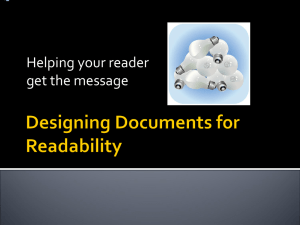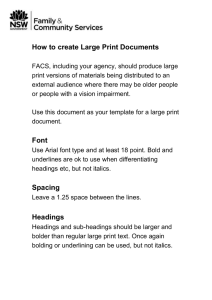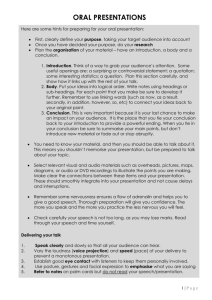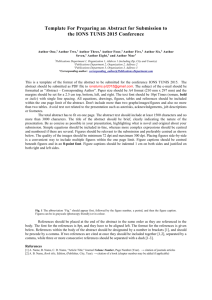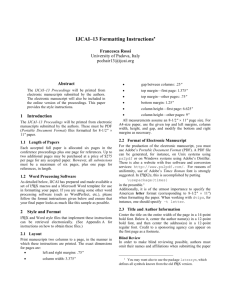Paper Template
advertisement
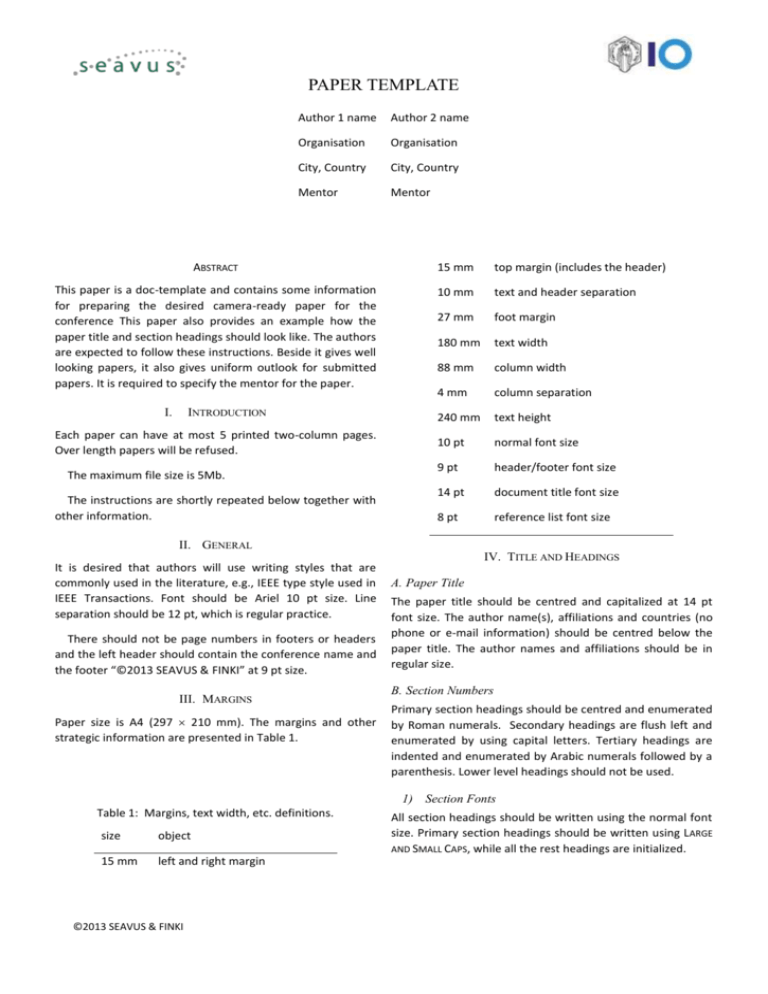
PAPER TEMPLATE Author 1 name Author 2 name Organisation Organisation City, Country City, Country Mentor Mentor ABSTRACT 15 mm top margin (includes the header) This paper is a doc-template and contains some information for preparing the desired camera-ready paper for the conference This paper also provides an example how the paper title and section headings should look like. The authors are expected to follow these instructions. Beside it gives well looking papers, it also gives uniform outlook for submitted papers. It is required to specify the mentor for the paper. 10 mm text and header separation 27 mm foot margin 180 mm text width 88 mm column width 4 mm column separation 240 mm text height 10 pt normal font size 9 pt header/footer font size 14 pt document title font size 8 pt reference list font size I. INTRODUCTION Each paper can have at most 5 printed two-column pages. Over length papers will be refused. The maximum file size is 5Mb. The instructions are shortly repeated below together with other information. II. GENERAL It is desired that authors will use writing styles that are commonly used in the literature, e.g., IEEE type style used in IEEE Transactions. Font should be Ariel 10 pt size. Line separation should be 12 pt, which is regular practice. There should not be page numbers in footers or headers and the left header should contain the conference name and the footer “©2013 SEAVUS & FINKI” at 9 pt size. III. MARGINS Paper size is A4 (297 210 mm). The margins and other strategic information are presented in Table 1. IV. TITLE AND HEADINGS A. Paper Title The paper title should be centred and capitalized at 14 pt font size. The author name(s), affiliations and countries (no phone or e-mail information) should be centred below the paper title. The author names and affiliations should be in regular size. B. Section Numbers Primary section headings should be centred and enumerated by Roman numerals. Secondary headings are flush left and enumerated by using capital letters. Tertiary headings are indented and enumerated by Arabic numerals followed by a parenthesis. Lower level headings should not be used. 1) Section Fonts Table 1: Margins, text width, etc. definitions. size object 15 mm left and right margin ©2013 SEAVUS & FINKI All section headings should be written using the normal font size. Primary section headings should be written using L ARGE AND SMALL CAPS, while all the rest headings are initialized. V. EQUATIONS Equations should be centred and numbered in parenthesis onto right hand side like b xt t sin qt dt . (1) a References to equations should be done using equation numbers, e.g., “In (1) t means time and q is a constant”. Mathematical variables should be written in italics whereas functions as regular text. Figure 1: An example. VI. REFERENCES References to figures and tables should be done as Fig. 1 and Table 1, respectively. The literature reference list should be made as in IEEE transactions using either full names or official abbreviations. The font size is 8 pt line spacing being 9.5 pt (thus reducing the size of the list). The references should be numbered in the order of appearance. In text, reference numbers are enclosed by square brackets, e.g., ‘In [1, 2, 3]’. VII. FIGURES AND TABLES Captions should be above tables and below figures. Tables, figures and their captions should be centred. Clarity is the key point in figures and tables. An example figure is Fig. 1. VIII. FINAL FORM The papers should be delivered exclusively at .pdf form. Please, follow closely the instructions in this file. REFERENCES [1] J. S. Abel, “A divide and conquer approach to least-squares estimation,” IEEE Transactions on Aerospace and Electronic Systems, vol. 26, no. 2, pp. 423427, March 1990. [2] P. R. Adry and M. A. H. Dempster, Introduction to Optimisation Methods. Chapman and Hall Ltd, London, 1974. [3] M. Haardt and E.A. Markus, “Unitary ESPRIT: How to exploit additional information inherent in the rotational invariance structure,” in Proceedings of the IEEE International Conference on Acoustics, Speech, and Signal Processing, 1994, vol. 4, pp. IV229IV232. ©2013 SEAVUS & FINKI
